Australia So Much to See


South of Alice Springs 2008 with visits to Ewaninga Conservation Reserve and Chambers Pillar Historic Reserve.

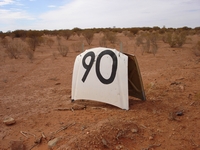
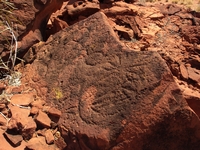
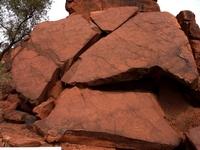
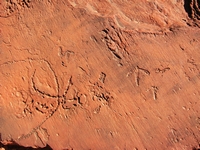
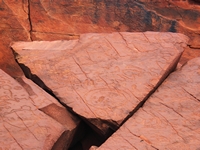
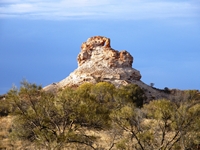
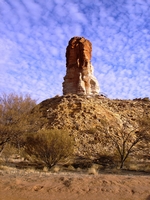
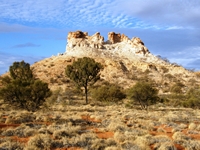
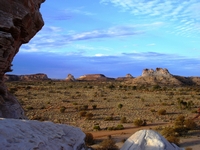
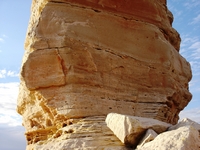
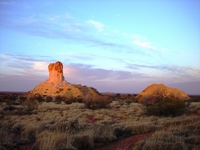
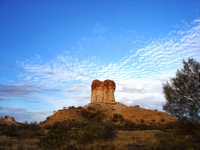
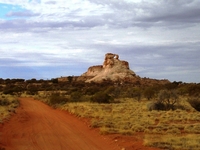
Leaving Alice Springs via the Old South Road (Finke Road), we followed the alignment of the former Ghan Railway. This line has
been disused since the re-alignment of the Ghan Railway line in 1980.
The small Aboriginal petroglyph site at Ewaninga almost forty kilometres south of Alice Springs consists of a group of sandstone
rocks, many with fine etchings, alongside a claypan. When it rained, the claypan would have been a source of water and food
when animals came to drink, so Ewaninga was a special place to the Arrernte people. The age of these petroglyphs is not known,
but they are believed to be very old.
Circles and animal prints are found throughout these etchings, which are considered sacred to the Arrernte people. The
meaning of these etchings is considered too sacred to be revealed. Arrernte women are asked to not visit.
Heading south along the Old South Road, which sometimes ran next to and sometimes on the same alignment as the old railway line, kilometre
markers were all made from two bonnets taken off the many wrecks along the roadside.
Diverting from the continuing road to Finke, which at this point becomes a narrow track, we headed towards Maryvale Station and the
track to Chambers Pillar.
After Maryvale and the adjacent Titjikala Community, the track deteriorated as it traversed 43 kilometres through the station.
Large areas of loose sand were not easy to tow through, and the hard areas of the track were quite corrugated. It was a steep climb to cross the Charlotte Ranges from the top of which Chambers Pillar could be seen in the distance. Before reaching
the Reserve, we crossed a number of sand dunes which had been stabilised with limestone to make crossing easy. The track was
narrow over the crests, and signage asked for travellers to announce their approach on two-way radio and specified channel 10. Being afternoon, traffic was all headed towards Chambers Pillar.
As we entered the Chambers Pillar Historical Reserve, one of the first rocks in view features a window, framed by the shape of a finger
and thumb making a circle, whilst clutching a smaller rock.
Castle Rock, with its different coloured layers of sandstone and its turret like formations, is near the Camp Ground, which has only
eight camp sites, isolated by bollards. We were the last rig in and were able to back into the long narrow but sloping last
remaining vacant camp site. Update November 2011 a new larger campground has just been created.
A closer view of Window Rock from a different angle, as seen from the camp ground.
The red sand extends from here to the Simpson Desert.
It is said that in the Dreamtime the Gecko ancestor Itirkawara left the Finke River and journeyed north east. As he travelled he grew
into a huge and powerful man with an extremely violent temper. On the way home he challenged and killed a number of his ancestors. Then he disregarded the strict marriage code and took a wife from the wrong skin group. His enraged relatives banished them both. The two retreated into the desert, Itirkawara raging in fury, the girl shrinking from him in deep shame. Among the dunes they rested
and turned into prominent rocky formations - Itirkawara into the Pillar, and the girl, still turning her face away from him in shame,
into Castle Rock.
The explorer, John MacDouall Stuart, heading north on his earliest attempt to cross Australia, first recorded the pillar in April
1860 and named it to honour his friend and financial supporter James Chambers. Prior to the overland railway, the Pillar was
a significant landmark in the desert for travellers. Messages were sometimes left at the base of the pillar. Early travellers
carved their names into the soft sandstone of the pillar, including John Ross, the leader of the exploring party for the Overland
Telegraph Line construction and his second in command Alfred Giles.
Chambers Pillar from the sunset viewing area late in the afternoon. Cloud cover then thickened and prevented a sunset glow.
From the platform on Chambers Pillar, looking towards Castle Rock and some of the other rocks.
A viewing platform has been constructed at the base of the Pillar to protect the fragile sandstone. Some visitors have even
graffitied the historic Pillar by carving their names amongst those of the early explorers.
The early light of sunrise lit up the Pillar and other nearby rocks.
All the campers left at much the same time next morning, announcing the group when crossing the dunes, although no oncoming traffic
was encountered.
We headed north along the Old South Road to the Hugh Stock Road turnoff. The Hugh Stock Road heads west through several stations
to cross the wide Hugh River bed before crossing the Ghan railway line then continues west until it meets the Stuart Highway. The clouds became denser, and rain could be seen towards the west in the distance. Which way would the shower go? Soon
after crossing the railway line, the looming dark clouds were soon alive with thunder and lightening. It was starting to rain
on us as we neared the Highway, and by the time we reached Stuart Wells Roadhouse ten kilometres to the north, the thunderstorm and
rain were in full fling.
Our plan was to drive into Rainbow Valley and spend the night there, but with the onset of rain
we were advised not to. Hence we returned to the caravan park at Alice Springs where we were laughed at when we said it had
rained. Rainbow Valley would wait for a sunny day. Unlike the cold windy weather we had experienced a few days earlier,
it was now warm and humid in Alice Springs.
Later, in fine weather, we left the caravan behind and headed through Owen
Springs Reserve and further south to visit Henbury Meteorites Conservation Reserve.
.
Copyright (C) 2013 AustraliaSoMuchtoSee.com. All rights reserved
See question and answer Visiting Chambers Pillar for more about road conditions, camping and places to leave your caravan if
it is not suitable to take on these roads.















